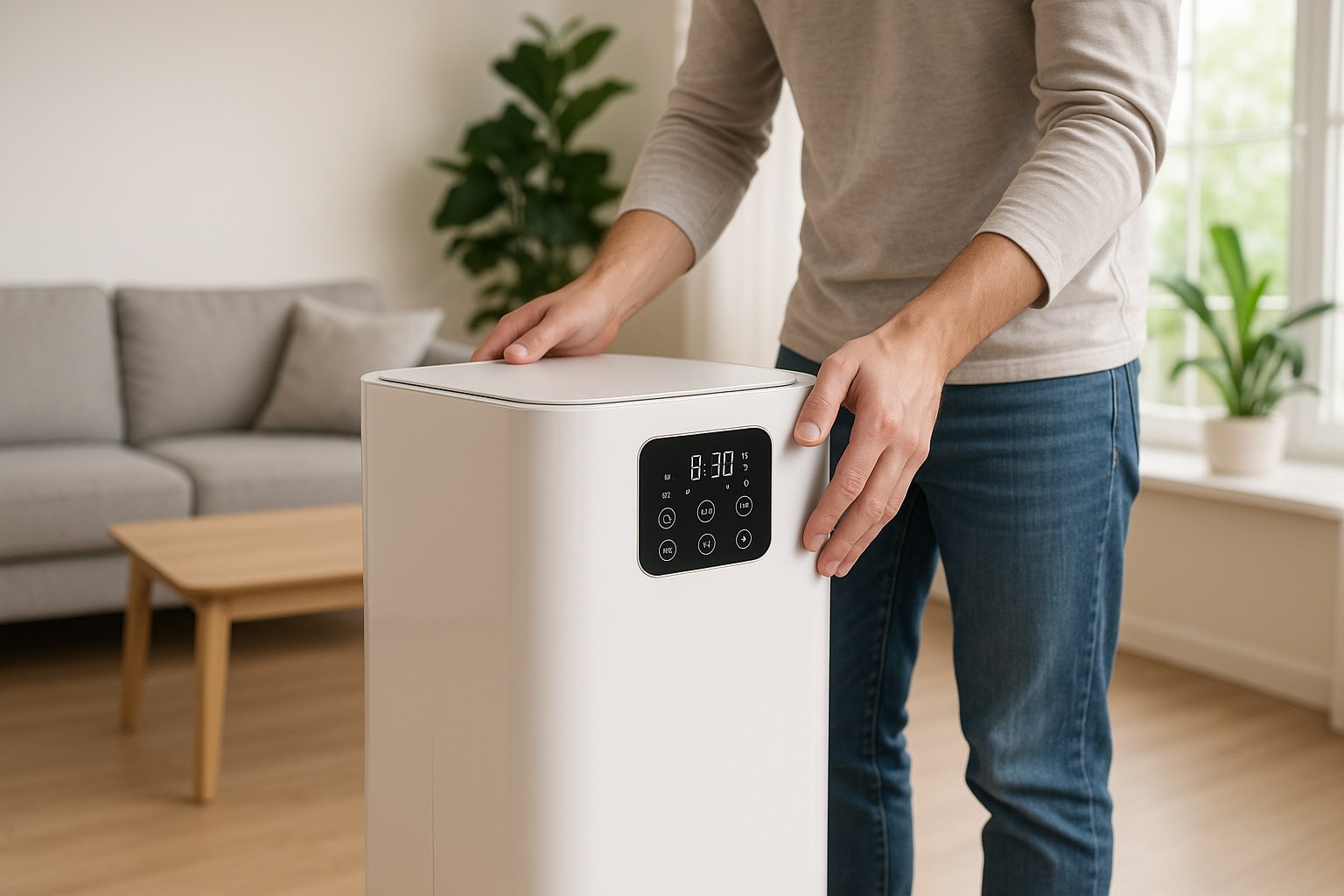How to Fix Window Condensation A Step by Step Guide
Waking up to find your windows covered in a layer of fog or even tiny water droplets can be a bit of a mystery. Is it a problem with the window? Is it too humid in your house? And most importantly, how do you get rid of it?
Window condensation is a common issue, especially during the colder months, but it’s not something you should ignore. While it might seem harmless, that moisture can lead to bigger problems down the line, like mold, mildew, and even water damage to your window sills and walls.
The good news is that in many cases, fixing window condensation is a straightforward DIY project. We’re here to walk you through it, just like a friendly expert over the phone. Let’s clear up those foggy windows for good.

What Causes Window Condensation Anyway?
Before we jump into the fix, let’s quickly cover the science. Condensation forms when warm, moist air comes into contact with a cooler surface. Your window panes are often one of the coldest surfaces in your home, especially in the winter. When the humid air inside your house hits that cold glass, the moisture in the air turns from a gas (water vapor) into a liquid (water droplets).
Think of it like a cold glass of lemonade on a hot summer day. The same principle applies to your windows. The key factors are indoor humidity levels and the surface temperature of your windows.
So, the first step in solving the problem is figuring out where the condensation is forming. This will tell you everything you need to know about what's causing it and how to fix it.
Step 1: Identify the Location of the Condensation
This is the most important diagnostic step, and it only takes a few minutes. You need to determine if the moisture is on the inside of your home, the outside, or trapped between the panes of glass.
- Grab a microfiber cloth.
- Wipe the interior side of the window glass. Does the condensation wipe away?
- If it doesn't, and if it's safe to do so, go outside and wipe the exterior side of the glass.
Now, let’s look at what your findings mean:
-
If the condensation was on the OUTSIDE: This is actually good news! It means your windows are well-insulated and doing their job of keeping heat inside your home. Exterior condensation happens when the outdoor air is humid and the window pane is cooler than the dew point. It’s a natural occurrence and usually disappears as the day warms up. You don't need to do anything.
-
If the condensation was on the INSIDE: This is the most common type of window condensation and it indicates that the humidity level inside your home is too high. This is something you can and should address. Proceed to the next section for the fix.
-
If you couldn't wipe the condensation away from either side: This means the moisture is trapped between the panes of glass. This is a sign that the seal on your double- or triple-pane window has failed. Unfortunately, this isn't a DIY fix. The gas fill (like argon or krypton) that once provided insulation has escaped, and moist air has gotten in. You’ll need to call a professional to either replace the insulated glass unit (IGU) or the entire window.
Step 2: How to Fix Condensation on the INSIDE of Your Windows
If you've determined your issue is high indoor humidity, it's time to take action. Everyday activities like cooking, showering, and even breathing release a surprising amount of moisture into the air. In fact, a family of four can produce over two gallons of water vapor per day! If that moisture has nowhere to go, it will end up on your windows.
Here's how to reduce your home's indoor humidity:
-
Use Your Fans: Ventilation is your best friend. Always run your bathroom's exhaust fan during and for at least 30 minutes after a shower. Do the same with your kitchen’s range hood when you’re cooking. These fans are designed to pull moist air directly out of your home.
-
Invest in a Dehumidifier: If you live in a particularly humid climate or have a room that’s consistently damp, a dehumidifier is a game-changer. Aim for an indoor humidity level between 30% and 50%. You can monitor this with a small, inexpensive device called a digital hygrometer.
-
Improve Air Circulation: Stagnant air can create pockets of high humidity. Keep interior doors open to allow air to circulate freely throughout your home. Using ceiling fans on a low, winter setting (spinning clockwise) can also help push warmer air down and keep the air moving.
-
Air Out Your House: When the weather permits, open your windows for 10-15 minutes each day. This allows the humid indoor air to escape and be replaced by drier outdoor air (this is especially effective in winter).

After taking these steps for a couple of days, check your windows again. If the interior condensation is gone, congratulations! You’ve solved the problem by balancing your home's humidity.
Step 3: What If the Condensation Is Still There? Inspect Your Window Seals
If you’ve reduced your indoor humidity but are still finding moisture on your windows, the next step is to check for air leaks around the window itself. A poor seal can let cold outside air seep in, making the interior surface of your window frame and glass even colder. This creates a prime spot for condensation to form, even with normal humidity levels.
Here’s how to inspect and reseal your windows:
-
Perform a Visual and Physical Check: Carefully examine the caulk around the interior and exterior of your window frame. Are there visible cracks or gaps? Is it pulling away from the frame? Check the weatherstripping as well—is it brittle, cracked, or compressed? On a windy day, you can also gently press along the frame and feel for cold drafts.
-
Remove the Old Caulk: If you find damaged caulk, you need to remove it before applying a new layer. Use a utility knife to carefully cut and scrape away the old, failing caulk.
-
Clean the Surface: Once the old caulk is gone, wipe the area with a damp microfiber cloth to remove any dust or debris. Let it dry completely.
-
Apply New Silicone Caulk: Using a caulk gun, apply a continuous, steady bead of high-quality silicone caulk into the joint where the window frame meets the wall. Silicone caulk is great for windows because it’s flexible and waterproof.
-
Smooth the Bead: For a clean, professional-looking seal, smooth the caulk bead with a wet finger or a caulk finishing tool. This pushes the caulk into the gap and creates a tight seal.
-
Let It Cure: Allow the new caulk to cure for at least 24 hours (or as directed by the manufacturer) before touching it or exposing it to moisture.
After the caulk has cured, monitor the window for a few days. If the condensation problem is gone, you’ve successfully stopped the air leak!
When It's Time to Call a Window Professional
While many condensation issues are solvable with a little DIY effort, some situations require an expert.
-
Condensation Between the Panes: As we mentioned, this means the window's seal has failed. A window repair specialist can often replace just the insulated glass unit without needing to replace the entire window frame, which can save you money. A typical IGU replacement can cost between $150 and $500, depending on the size and type of window.
-
Persistent Interior Condensation: If you've lowered your humidity and resealed your windows, but the fog keeps coming back, it may point to a more significant issue, like a hidden water leak in the wall or poor insulation around the window frame. A professional can use tools like thermal cameras to diagnose these hard-to-find problems.

Final Thoughts
Dealing with foggy windows is more than just an aesthetic issue—it's about protecting your home's health. By identifying the source of the condensation and taking the right steps, you can prevent moisture damage and maintain a more comfortable living environment.
Ready to take control of your home maintenance? Download the Casa app today! Casa provides easy-to-follow guides for all your DIY projects and connects you with trusted, vetted professionals for the jobs that need an expert touch. From foggy windows to leaky faucets, we’re here to help you care for your home with confidence.

